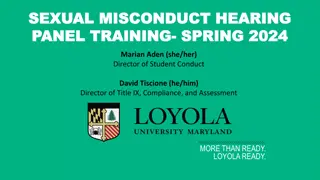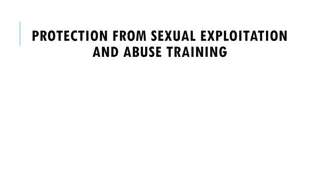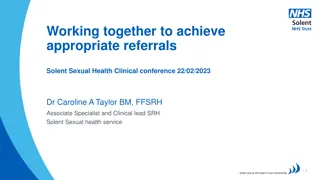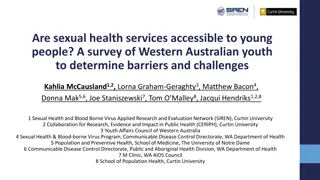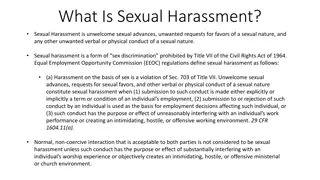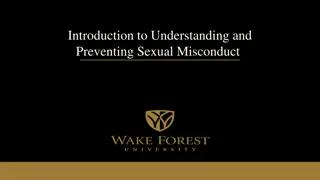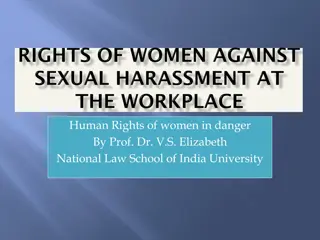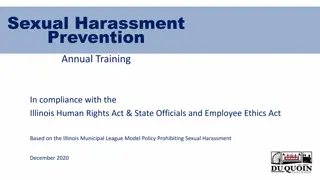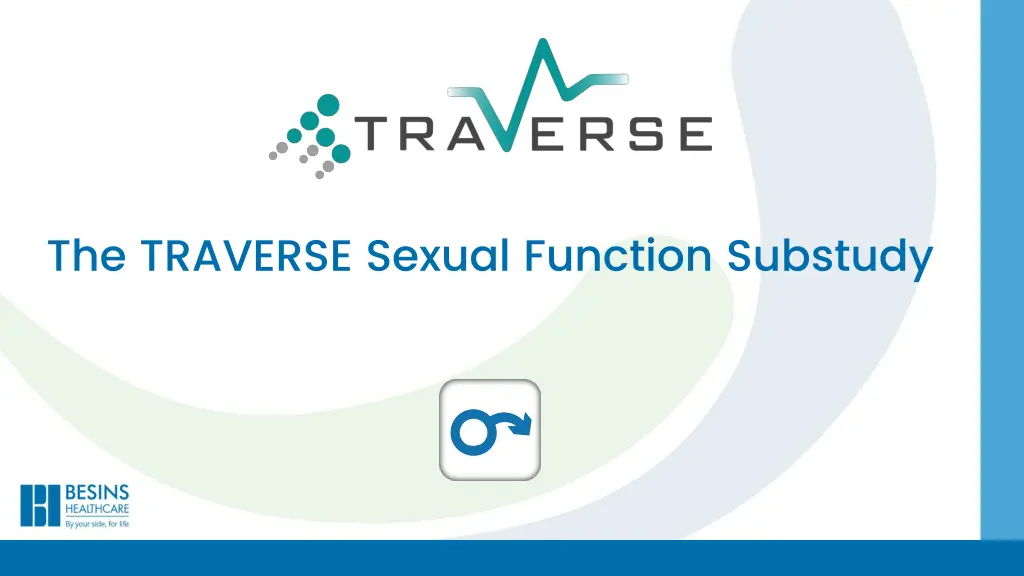
Understanding TRAVERSE Sexual Function Substudy Results
Explore the TRAVERSE Sexual Function Substudy, which evaluates the effects of testosterone replacement therapy on sexual activity and hypogonadism in men with low libido. The study aims to determine the impact of TRT on overall sexual activity, maintenance of improvements over time, and symptom relief compared to a placebo. Dive into the baseline characteristics, cardiovascular risk factors, and the effects of testosterone or placebo on sexual function. Find out how TRT could potentially improve sexual desire and erectile function in men with hypogonadism.
Download Presentation

Please find below an Image/Link to download the presentation.
The content on the website is provided AS IS for your information and personal use only. It may not be sold, licensed, or shared on other websites without obtaining consent from the author. If you encounter any issues during the download, it is possible that the publisher has removed the file from their server.
You are allowed to download the files provided on this website for personal or commercial use, subject to the condition that they are used lawfully. All files are the property of their respective owners.
The content on the website is provided AS IS for your information and personal use only. It may not be sold, licensed, or shared on other websites without obtaining consent from the author.
E N D
Presentation Transcript
TRAVERSE Sexual Function Substudy: aims TRAVERSE TRAVERSE Sexual Function Sub Sexual Function Substudy study Primary To evaluate whether TRT for 1 year in men with hypogonadism and low libido improves overall sexual activity more than placebo Secondary To determine whether improvements in sexual activity over 1 year are maintained after 2 years of TRT versus placebo To determine whether TRT improves hypogonadal symptoms more than placebo over 1 and 3 years of treatment To determine whether TRT improves sexual desire and erectile function more than placebo over 1 year To determine whether the improvements in sexual desire and erectile function over 1 year are maintained after 2 years TRT, testosterone replacement therapy.
TRAVERSE Sexual Function Substudy: results Baseline characteristics, CVD and risk factors Baseline characteristics, CVD and risk factors Testosterone (n=587) Placebo (n=574) Mean (SD) age, years Age 65 years, n (%) of patients 64.0 7.5 299 (50.9) 63.3 7.8 279 (48.6) Race/ethnicity, n (%) of patients White Black or African American Other 488 (83.1) 82 (14.0) 17 (2.9) 475 (82.8) 75 (13.1) 24 (4.2) Prior testosterone use, n (%) of patients 2 (0.3) 2 (0.3) Prior CVD, n (%) of patients 289 (49.2) 294 (51.2) At risk for CVD, n (%) of patients 298 (50.8) 280 (48.8) Dyslipidaemia, n (%) of patients 542 (92.3) 527 (91.8) Hypertension, n (%) of patients 559 (95.2) 529 (92.2) CVD, cardiovascular disease; SD, standard deviation.
TRAVERSE Sexual Function Substudy: results Baseline h Baseline hypogonadism and sexual function ypogonadism and sexual function Testosterone (n=587) Placebo (n=574) Sexual activity: PDQ-4 score Mean (SD) PDQ-4 score per day Not sexually active (PDQ-4 score = 0), n (%) of patients 1.8 (1.7) 1.8 (1.8) 70 (11.9) 59 (10.3) Mean (SD) HIS-Q composite total score 46.9 (11.5) [n=563] 46.8 (12.0) [n=550] Mean (SD) HIS-Q sexual function domain score 63.1 (19.0) [n=565] 63.4 (19.7) [n=553] Mean (SD) HIS-Q libido subdomain score 65.4 (16.8) [n=567] 65.8 (17.1) [n=553] Mean (SD) DISF Desire score* 12.0 (5.3) 12.0 (5.2) Mean (SD) IIEF total score 13.0 (5.7) [n=328] 12.8 (5.7) [n=325] Using a PDE-5 inhibitor, n (%) of patients 51 (8.7) 56 (9.8) *A DISF Desire score <20 was an inclusion criterion of the TRAVERSE Sexual Function Substudy. DISF, DeRogatis Interview for Sexual Functioning; HIS-Q, Hypogonadism Impact of Symptoms Questionnaire; IIEF, International Index of Erectile Function; PDE-5, phosphodiesterase type 5; PDQ-4, Psychosexual Daily Diary Question 4; SD, standard deviation.
TRAVERSE Sexual Function Substudy: results Effect of testosterone or placebo on sexual activity Effect of testosterone or placebo on sexual activity Hypogonadal men with low libido at baseline Testosterone Placebo PDQ-4 to evaluate sexual activity The PDQ is a daily self-reported questionnaire Change from baseline Estimated mean (95% CI) between-group difference in acts per day; omnibus test p=0.011 2.0 Q4. For all the items below, select yes if you have experienced (or are experiencing) today, otherwise select no Sexual daydreams Anticipation of sex Sexual interactions with partner Flirting (by you) Orgasm Flirting (by others toward you) Ejaculation Y N in PDQ-4 score 0.48 0.49 0.47 1.5 (-0.01, 0.96) (0.19, 0.79) (0.11, 0.83) Intercourse Masturbation Night spontaneous erection Day spontaneous erection Erection in response to sexual activity Y N Y N Y N Y N Y N Y N Y N Y N Y N 1.0 Y N 0.5 Y N 0 0 6 12 24 PDQ-4 score is calculated as the average of the weekly values for all items (+1 for every yes and 0 for every no) at 6, 12 or 24 months since baseline Months since randomisation Patients, n Testosterone Placebo 587 574 260 259 170 171 106 95 Lee KK et al. J Androl 2003;24:688 98. CI, confidence interval; PDQ-4, Psychosexual Daily Diary Question 4.
TRAVERSE Sexual Function Substudy: results Prespecified analyses: effect on sexual activity by PDQ Prespecified analyses: effect on sexual activity by PDQ- -4 score 4 score The observed significant improvements in PDQ-4 score with testosterone versus placebo were irrespective of the following: Subgroup p value for interaction <65 years 65 years Yes No Age 0.338 Prior CVD 0.421 <250 ng/dL (<8.7 nmol/L) 250 ng/dL ( 8.7 nmol/L) Black White Baseline >0.05 testosterone level Race/ethnicity >0.05 PDQ-4, Psychosexual Daily Diary Question 4.
TRAVERSE Sexual Function Substudy: results Effects on symptoms of hypogonadism evaluated using the HIS Effects on symptoms of hypogonadism evaluated using the HIS- -Q Q Sexual Function substudy Full Analysis set Change from baseline Change from baseline Testosterone Placebo Testosterone Placebo Estimated mean (95% CI) between-group difference; omnibus test p=0.001 Estimated mean (95% CI) between-group difference; omnibus test p<0.001 5 5 in HIS-Q composite in HIS-Q composite -2.7 0 0 -2.3 -1.6 -1.5 (-4.3, -1.0) (-3.6, -1.0) -2.5 (-2.2, -0.9) -1.7 (-2.3, -0.7) (-3.9, -1.1) (-2.3, -1.0) -5 -5 -10 -10 0 6 12 24 0 6 12 24 Months since randomisation Months since randomisation Patients, n Testosterone Placebo 587 574 476 464 384 388 305 285 2601 2603 2054 2019 1694 1679 1267 1206 CI, confidence interval; HIS-Q, Hypogonadism Impact of Symptoms Questionnaire.
TRAVERSE Sexual Function Substudy: results Effects on sexual symptoms evaluated using the HIS Effects on sexual symptoms evaluated using the HIS- -Q Q Sexual Function substudy Full Analysis set in HIS-Q sexual function in HIS-Q sexual function Change from baseline Change from baseline Testosterone Placebo Testosterone Placebo Estimated mean (95% CI) between-group difference; omnibus test p=0.019 Estimated mean (95% CI) between-group difference; omnibus test p=0.001 5 5 -4.0 -3.4 -2.7 (-6.8, -1.3) 0 0 (-6.4, -0.3) (-5.1, -0.3) -5 -5 -10 -10 0 6 12 24 0 6 12 24 Months since randomisation Months since randomisation Patients, n Testosterone Placebo 587 574 481 471 388 394 307 288 2601 2603 2077 2042 1714 1703 1289 1218 CI, confidence interval; HIS-Q, Hypogonadism Impact of Symptoms Questionnaire.
TRAVERSE Sexual Function Substudy: results Effects on sexual desire evaluated using the HIS Effects on sexual desire evaluated using the HIS- -Q Q Sexual Function substudy Full Analysis set Change from baseline Change from baseline Testosterone Placebo Testosterone Placebo Estimated mean (95% CI) between-group difference; omnibus test p=0.001 Estimated mean (95% CI) between-group difference; omnibus test p<0.001 5 5 in HIS-Q libido in HIS-Q libido 0 0 -3.9 -3.4 -3.3 (-5.8, -1.9) (-5.9, -0.9) (-5.5, -1.1) -5 -5 -10 -10 0 6 12 24 0 6 12 24 Months since randomisation Months since randomisation Patients, n Testosterone Placebo 587 574 484 473 390 394 308 288 2601 2603 2082 2042 1715 1711 1287 1224 CI, confidence interval; HIS-Q, Hypogonadism Impact of Symptoms Questionnaire.
TRAVERSE Sexual Function Substudy: results Effects on erectile function evaluated using the IIEF Effects on erectile function evaluated using the IIEF- -5 5 Sexual Function substudy Change from baseline Testosterone Placebo Estimated mean (95% CI) between-group difference; omnibus test p=0.443 5 in IIEF-5 score 4 3 2 1 0 0 12 24 Months since randomisation Patients, n Testosterone Placebo 587 574 181 161 58 50 CI, confidence interval; IIEF-5, International Index of Erectile Function.
TRAVERSE Sexual Function Substudy Conclusions Conclusions In middle-aged and older men with hypogonadism and established CVD or multiple risk factors for incident cardiac events, who also reported low libido: Testosterone was significantly more efficacious than placebo at improving overall sexual activity, hypogonadal symptoms and sexual desire, but not erectile function The improvements in sexual activity over 1 year were maintained for up to 2 years of treatment CVD, cardiovascular disease.
The TRAVERSE Trial Overall synthesis Overall synthesis TRAVERSE, the largest RCT of TRT to date, has provided important data on the CV and prostate safety of TRT and its effects on several efficacy endpoints The findings apply only to middle-aged and older men with a confirmed diagnosis of hypogonadism, and should not be extended to men who do not have hypogonadism or to longer treatment durations Rates of loss-to-follow-up and study drug discontinuation were high, but not dissimilar to those in RCTs in other symptomatic conditions; non-retention rates were similar The trial s findings will facilitate a more informed consideration of the potential benefits and risks of TRT and treatment decisions in middle-aged and older men with hypogonadism CV, cardiovascular; RCT, randomised controlled trial; TRT, testosterone replacement therapy.





